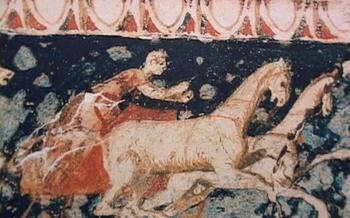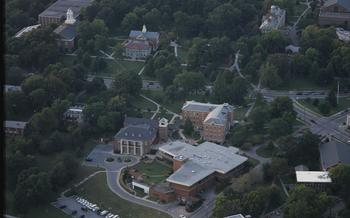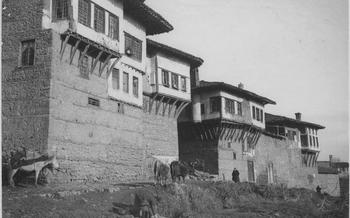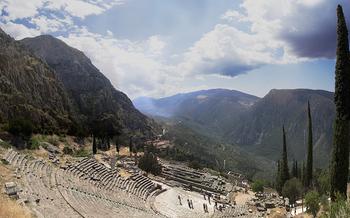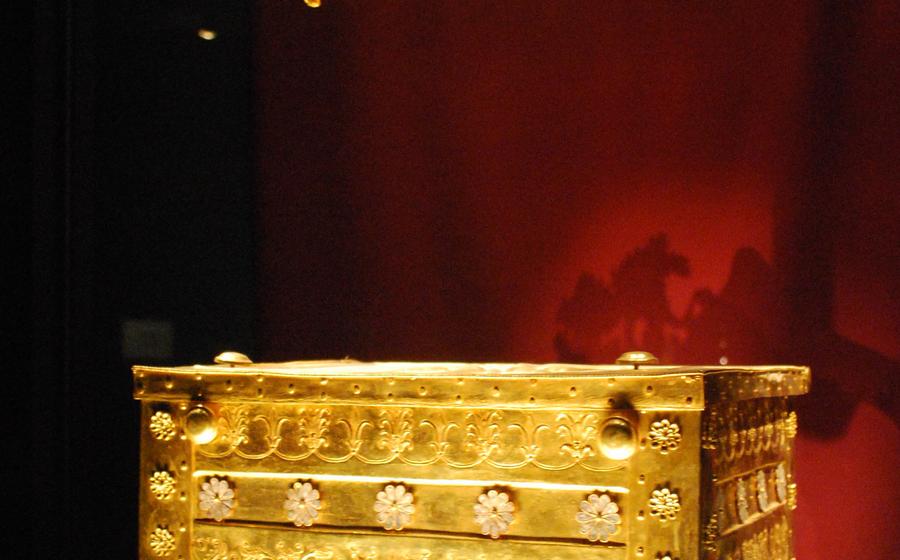
Vergina Tomb Museum
- Alexander the Great's Connection
- Golden Artifacts: Treasures of the Macedonian Dynasty
- Interactive Exhibits: Engaging with the Past
- Guided Tours: Unlocking the Secrets of the Museum
- Educational Programs: Learning from the Past
- Research Center: Uncovering the Mysteries of Macedonia
- Accessibility: Ensuring Inclusivity for All
- Museum Shop: Treasures to Take Home
- Café and Restaurant: Refreshment with a View
- Location and Transportation: Getting There with Ease
- Opening Hours and Admission: Planning Your Visit
- Insider Tip: Exploring Beyond the Museum
Alexander the Great's Connection
The Vergina Tomb Museum is inextricably linked to Alexander the Great, one of history's most renowned figures. The museum houses the tomb of Alexander's father, King Philip II, an influential ruler who laid the foundation for Alexander's future conquests. The discovery of Philip's tomb in 1977 was a pivotal moment in archaeological history, shedding new light on Alexander's upbringing and the influences that shaped his character.
The museum's exhibits provide valuable insights into Alexander's early life and the environment in which he grew up. Visitors can admire the intricate artwork and artifacts found in Philip's tomb, including the golden larnax, which once held the king's remains. These treasures offer a glimpse into the opulence and grandeur of the Macedonian court and the wealth that Alexander inherited.
The museum also explores the relationship between Philip and Alexander, highlighting Philip's role as a mentor and teacher to his son. Through interactive exhibits and multimedia presentations, visitors can learn about Philip's military strategies and diplomatic skills, which he passed on to Alexander. The museum's collection provides a fascinating window into the formative years of one of history's greatest leaders.
Golden Artifacts: Treasures of the Macedonian Dynasty
The Vergina Tomb Museum houses a dazzling array of gold artifacts that offer a glimpse into the opulence and craftsmanship of the ancient Macedonian dynasty. These exquisite objects, crafted with meticulous care and adorned with intricate designs, serve as testaments to the wealth and power of the Macedonian rulers.
Among the most notable artifacts is the golden larnax, an ornate container that held the remains of King Philip II, father of Alexander the Great. This masterpiece of ancient goldsmithing features intricate repoussé work depicting scenes from Greek mythology, including the battle between the gods and the giants. The larnax is a testament to the exceptional skills of Macedonian artisans and the importance of gold in Macedonian culture.
Other notable gold artifacts include jewelry, weapons, and decorative objects. Gold earrings, necklaces, and bracelets adorned the bodies of the deceased, symbolizing their status and wealth. Gold-plated weapons, such as swords and shields, were not only functional but also served as symbols of power and authority. Gold vessels, such as cups and plates, were used for banquets and other special occasions, reflecting the lavish lifestyle of the Macedonian elite.
The golden artifacts of the Vergina Tomb Museum provide a tangible connection to the past, offering insights into the lives, beliefs, and customs of the ancient Macedonians. They are a testament to the skill and artistry of ancient craftsmen and the enduring legacy of the Macedonian dynasty.
Interactive Exhibits: Engaging with the Past
The Vergina Tomb Museum offers a variety of interactive exhibits that enhance the visitor experience and bring the past to life. Virtual reality tours take visitors on a journey through the ancient tombs, allowing them to explore the burial chambers and artifacts in a realistic and immersive way. Touchscreens and multimedia presentations provide in-depth information about the museum's collection and the history of Macedonia. Hands-on activities, such as pottery making and coin minting, allow visitors to immerse themselves in Macedonian culture and gain a deeper understanding of the daily lives of the ancient Macedonians. Through these interactive exhibits, the museum creates a dynamic and engaging learning environment that appeals to visitors of all ages and interests.
Guided Tours: Unlocking the Secrets of the Museum
Strolling through the hallowed halls of the Vergina Tomb Museum on your own is an enriching experience. However, to truly delve into the depths of Macedonian history and culture, consider embarking on a guided tour. These tours, led by knowledgeable and passionate guides, offer a unique opportunity to unlock the secrets of the museum's exhibits and gain a deeper understanding of their significance.
With their expertise, the guides bring the past to life, weaving tales of ancient Macedonian royalty, their triumphs, and their legacies. They provide historical context, explain the symbolism behind the artifacts, and offer insights into the lives and customs of the Macedonian people. Engaging in discussions with these experts enhances the experience, allowing you to ask questions, seek clarification, and delve deeper into specific aspects of Macedonian history that pique your interest.
Guided tours are available in various languages, ensuring that international visitors can also benefit from the wealth of knowledge shared by the guides. Whether you're an avid history buff, a casual traveler, or simply seeking a more immersive experience, guided tours at the Vergina Tomb Museum are highly recommended. They provide an unparalleled opportunity to explore the museum's treasures and gain a profound understanding of the rich heritage of Macedonia.
Educational Programs: Learning from the Past
The Vergina Tomb Museum extends its impact beyond its exhibits, playing a crucial role in educating and engaging the public. The museum's educational programs cater to students and adults, providing a platform for deeper learning and exploration of Macedonian history and archaeology.
Interactive workshops, captivating lectures, and hands-on activities bring the past to life, allowing participants to engage with historical artifacts, discover archaeological techniques, and delve into the fascinating world of ancient Macedonia. Archaeological demonstrations and immersive experiences further enhance the learning process, fostering a sense of connection to the region's rich cultural heritage.
Through these educational initiatives, the museum promotes cultural awareness and fosters a deeper appreciation for the legacy of ancient Macedonia. It empowers visitors to become active participants in preserving and understanding the region's historical treasures, ensuring that the stories of the past continue to inspire and educate future generations.
Research Center: Uncovering the Mysteries of Macedonia
The Vergina Tomb Museum is not just a repository of ancient artifacts; it is also an active center of research dedicated to uncovering the mysteries of Macedonia's rich past. The museum houses a state-of-the-art research center that brings together a team of archaeologists, historians, and conservators who are committed to advancing our understanding of this ancient civilization. The center is equipped with cutting-edge technology, including laboratories, libraries, and digital archives, which facilitate in-depth research on excavated artifacts and historical records.
Ongoing excavations and research projects are conducted in collaboration with international institutions, fostering knowledge-sharing and promoting a global understanding of Macedonia's history. The center's findings are disseminated through publications, conferences, and educational programs, ensuring that the latest discoveries and insights are accessible to scholars, educators, and the general public alike.
The research center plays a crucial role in preserving Macedonia's cultural heritage and advancing our knowledge of this fascinating civilization. Its contributions to the field of archaeology have shed new light on the lives, customs, and achievements of the ancient Macedonians, enriching our understanding of their enduring legacy.
Accessibility: Ensuring Inclusivity for All
The Vergina Tomb Museum is committed to providing an accessible and inclusive environment for all visitors. The museum has implemented various measures to ensure that people with disabilities can fully experience and enjoy the museum's exhibits.
Wheelchair ramps and elevators provide easy access to all levels of the museum, allowing visitors with mobility impairments to navigate the space comfortably. Tactile exhibits and audio guides for the visually impaired offer an immersive experience for those who are blind or have low vision.
The museum also offers sign language interpretation and multilingual tours for international visitors, ensuring that everyone has the opportunity to understand and appreciate the museum's collection. These services can be arranged in advance to accommodate the needs of visitors with hearing impairments or those who prefer tours in their native language.
By creating an inclusive environment, the Vergina Tomb Museum strives to make its treasures accessible to everyone, regardless of their abilities or backgrounds. Visitors can fully immerse themselves in the museum's exhibits, learn about Macedonian history and culture, and appreciate the beauty and significance of the artifacts on display.
Museum Shop: Treasures to Take Home
The Vergina Tomb Museum houses a well-stocked museum shop that offers a treasure trove of souvenirs and replicas for visitors to take home. From books and postcards to educational materials, the shop provides a wide range of options for those who wish to delve deeper into Macedonian history and culture.
Among the highlights of the museum shop are unique souvenirs inspired by the museum's collection. These include replicas of ancient artifacts, such as jewelry, pottery, and coins, allowing visitors to possess a tangible piece of Macedonian history.
By purchasing souvenirs from the museum shop, visitors not only take home a memento of their visit but also support the museum's mission to preserve and promote Macedonian heritage. The revenue generated from the shop contributes to the museum's ongoing research, conservation, and educational initiatives.
So, whether you are looking for a thoughtful gift for a history buff or simply want to remember your time at the Vergina Tomb Museum, be sure to visit the museum shop. It is a treasure trove of unique and meaningful items that will remind you of your journey through ancient Macedonia.
Café and Restaurant: Refreshment with a View
Amidst the exploration of ancient treasures, the Vergina Tomb Museum offers visitors a sanctuary for refreshment and contemplation. The museum's café and restaurant provide a welcome respite, inviting visitors to indulge in culinary delights while immersed in the ambiance of history.
The café, with its inviting aroma of freshly brewed coffee and delectable pastries, beckons weary travelers to take a break and savor a moment of tranquility. Sip on a rich espresso while admiring the intricate artwork adorning the walls, or relish a refreshing fruit juice as you soak in the serene atmosphere.
For those seeking a more substantial repast, the museum's restaurant offers a tempting array of local delicacies and traditional Greek cuisine. Delight in the flavors of slow-cooked stews, savor the freshness of crisp salads, and indulge in the sweetness of homemade desserts.
The outdoor terrace of the café offers a unique dining experience, with stunning views of the surrounding landscape. As you savor your meal, let your gaze wander across the lush gardens, where ancient artifacts whisper tales of a bygone era.
The Vergina Tomb Museum's café and restaurant are not mere culinary destinations; they are integral parts of the museum experience, offering visitors a chance to relax, reflect, and immerse themselves in the rich tapestry of Macedonian history.
Location and Transportation: Getting There with Ease
The Vergina Tomb Museum is conveniently located in the city of Veria, in the Central Macedonia region of Greece. Its central location makes it easily accessible by various means of transportation.
For those traveling by public transportation, buses and taxis are readily available to take you to the museum. The bus stop is situated just a short walk from the museum, and taxis can be hailed from anywhere in the city.
If you prefer to drive, the museum is well-connected by road. Ample parking facilities are available for visitors arriving by car, ensuring a hassle-free visit.
The museum's proximity to other historical and cultural attractions in the region makes it an ideal starting point for exploring the rich heritage of Macedonia. From Veria, you can easily visit the ancient city of Pella, the birthplace of Alexander the Great, or explore the nearby archaeological sites of Aigai and Dion.
Whether you choose to arrive by public transportation or by car, the Vergina Tomb Museum is easily accessible, allowing you to immerse yourself in the fascinating history and culture of ancient Macedonia.
Opening Hours and Admission: Planning Your Visit
The Vergina Tomb Museum is open to the public from Tuesday to Sunday, with varying hours depending on the season. During the summer months (April to October), the museum is open from 8:00 AM to 8:00 PM, while in the winter months (November to March), it operates from 8:30 AM to 3:00 PM. On Mondays, the museum is closed, except for public holidays.
Admission fees are charged for entry to the museum, with reduced rates for students, seniors, and families. Visitors can purchase tickets at the museum's ticket counter or book their tickets in advance online to avoid queues. Advance booking is highly recommended for groups and special events.
When planning your visit, it is advisable to allocate sufficient time to explore the museum's exhibits and immerse yourself in the history and culture of ancient Macedonia. The museum's layout is well-organized, and visitors can follow a suggested route to ensure they see all the highlights. Guided tours are also available for a more in-depth experience, providing valuable insights and historical context.
To make the most of your visit, consider visiting during the shoulder seasons (May-June and September-October) when the weather is pleasant, and there are fewer crowds. The museum can get busy during the peak tourist season (July-August), so it is advisable to arrive early or visit later in the day to avoid the rush.
Remember to bring your camera to capture the stunning artifacts and artwork on display. Flash photography is not permitted inside the museum, but natural light provides ample illumination for taking memorable photos.
As you explore the Vergina Tomb Museum, take your time to appreciate the exquisite craftsmanship and historical significance of the artifacts on display. Each piece tells a story about the rich cultural heritage and legacy of ancient Macedonia, offering a glimpse into the lives and achievements of a remarkable civilization.
Insider Tip: Exploring Beyond the Museum
While the Vergina Tomb Museum is a must-visit destination, there's so much more to explore in the region to deepen your understanding of Macedonian history and culture. Here are some insider tips:
-
Visit the Ancient City of Aigai: Located just a short drive from Vergina, Aigai was the first capital of the Kingdom of Macedonia and the birthplace of Alexander the Great. Explore its well-preserved ruins, including the royal palace, the theater, and the agora.
-
Discover the Archaeological Museum of Veria: This museum houses a collection of artifacts from the ancient city of Veria, including sculptures, pottery, and jewelry. Gain insights into the daily life, customs, and artistic traditions of the ancient Macedonians.
-
Immerse Yourself in the Royal Tombs of Aigai: In addition to the tombs at the Vergina Tomb Museum, there are several other royal tombs located in the area, including the Tomb of Eurydice I, the wife of King Philip II. These tombs offer a glimpse into the lives and burials of the Macedonian royal family.
-
Attend Local Festivals and Events: Throughout the year, Veria and the surrounding region host various festivals and events that celebrate Macedonian culture and traditions. These events provide a unique opportunity to experience traditional music, dance, food, and crafts.
-
Connect with Local Experts: Engage with local historians, archaeologists, and tour guides to gain personalized insights into Macedonian history and culture. They can recommend hidden gems, share local stories, and help you create a truly immersive experience.

